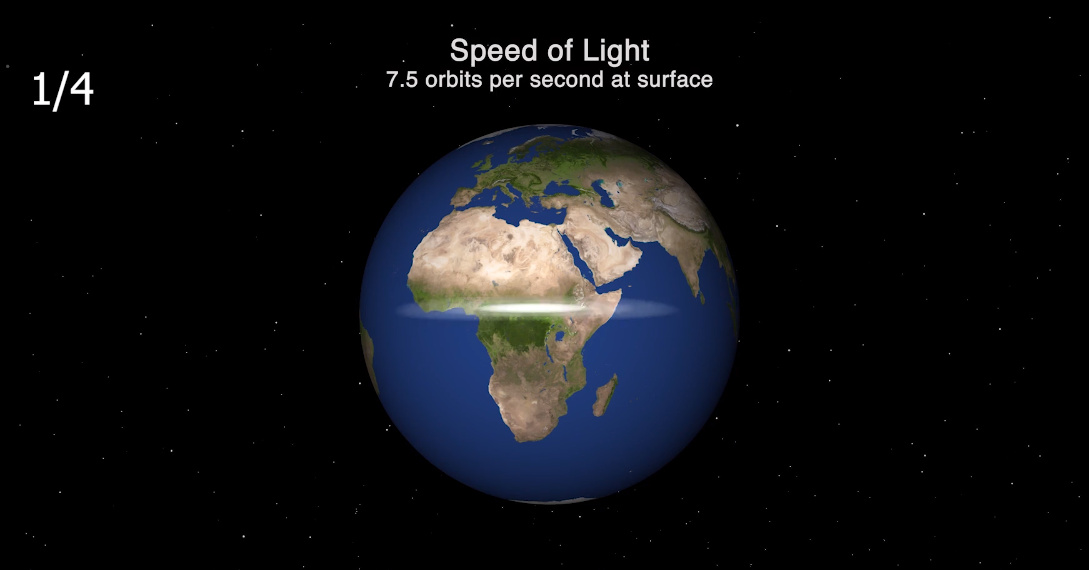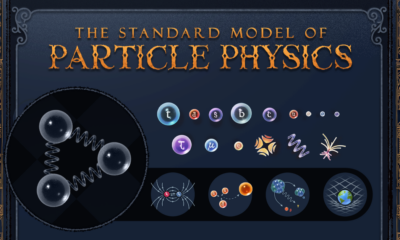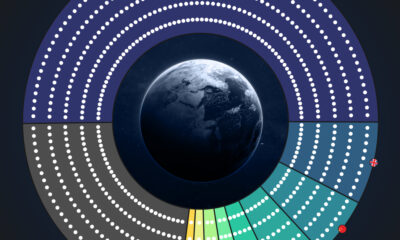Misc
Visualizing the Speed of Light (Fast, but Slow)
Visualizing the Speed of Light
With the flip of a switch, your room can be instantenously flooded with brightness.
In fact, there is no noticeable lag effect at all.
That’s because emitted photons travel at 186,000 miles (300,000 km) per second, meaning it takes only 1/500,000th of a second for light to reach even the furthest part of an ordinary room. And, if it could go through the wall, it would orbit the entire planet 7.5 times in just one second.
Light Speed is Fast…
In our every day experiences, we never see light as having to “take time” to do anything. It’s inconceivably fast, brightening up everything in its path in an instant — and with a few odd caveats, scientists believe light speed to be the fastest-known achievable pace in the universe.
But what if we get out of our bubble, and look at light from outside the confines of life on Earth?
Today’s animation, which comes from planetary scientist Dr. James O’Donoghue, helps visualize the speed of light in a broader context. It helps remind us of the mechanics of this incredible phenomenon, while also highlighting the vast distances between celestial bodies — even in our small and insignificant corner of the solar system.
Light Speed is Slow…
Once a photon is sent into the vast abyss, suddenly the fastest possible speed seems somewhat pedestrian.
- Moon: It takes about 1.255 seconds for light to get from Earth to the moon.
- Mars: Mars is about 150x further than the moon — about 40 million miles (54.6 million km) in the closest approach — so it takes 3 minutes to get there from Earth.
- Sun: The sun is 93 million miles (150 million km) away, meaning it takes 8 minutes to see its light.
Let that sink in for a moment: the sun could explode right now, and we wouldn’t even know about it for eight long minutes.
Going Further, Taking Longer
If it takes light a few minutes to get to the closest planets, how long does it take for light to travel further away from Earth?
- Jupiter: The largest planet is 629 million km away when it’s closest, taking light about 35 minutes.
- Saturn: The ringed planet is about as twice as far as Jupiter, taking light 71 minutes.
- Pluto: It takes about 5.5 hours for light to go from Earth to the dwarf planet.
- Alpha Centauri: The nearest star system is 4.3 light years away, or 25 trillion miles (40 trillion km).
- Visible stars: The average distance to the 300 brightest stars in the sky is about 347 light years.
If you really want to get the feeling of how “slow” light really is, watch the below video and journey from the sun to Jupiter. It’s done in real-time, so it takes about 43 minutes:
So while light obviously travels at a ludicrous speed, it really depends on your vantage point.
On Earth, light is instantaneous – but anywhere else in the universe, it’s pretty inadequate for getting anywhere far (especially in contrast to the average human lifespan).
Misc
Visualizing the Most Common Pets in the U.S.
Lions, tigers, and bears, oh my!—these animals do not feature on this list of popular American household pets.

Visualizing The Most Common Pets in the U.S.
This was originally posted on our Voronoi app. Download the app for free on iOS or Android and discover incredible data-driven charts from a variety of trusted sources.
In this graphic, we visualized the most common American household pets, based on 2023-2024 data from the American Pet Products Association (accessed via Forbes Advisor).
Figures represent the number of households that own each pet type, rather than the actual number of each animal. The “small animal” category includes hamsters, gerbils, rabbits, guinea pigs, chinchillas, mice, rats, and ferrets.
What is the Most Popular American Household Pet?
Based on this data, dogs—one of the first domesticated animals—are the most common pets in the United States. In fact, around 65 million households own a dog, and spend an average of $900 a year on their care.
| Rank | Species | Households |
|---|---|---|
| 1 | 🐶 Dog | 65M |
| 2 | 🐱 Cat | 47M |
| 3 | 🐟 Freshwater Fish | 11M |
| 4 | 🐰 Small Animals | 7M |
| 5 | 🐦 Bird | 6M |
| 6 | 🦎 Reptile | 6M |
| 7 | 🐴 Horse | 2M |
| 8 | 🐠 Saltwater Fish | 2M |
Note: Households can own multiple pets, and are counted for all relevant categories.
Cats rank second, at 47 million households, and these smaller felines are a little less expensive to own at $700/year according to Forbes estimates.
But aside from these two juggernauts, there are plenty of other common pet types found in households across the country.
Freshwater fish can be found in 11 million households, along with small animals—rabbits, hamsters, guinea pigs—in 7 million. Meanwhile, nearly 6 million homes have birds or reptiles.
Pet Ownership is on the Rise in America
Forbes found that 66% of all American households (numbering 87 million) own at least one pet, up from 56% in 1988. One third of these (29 million) own multiple pets.
A combination of factors is driving this increase: rising incomes, delayed childbirth, and of course the impact of the pandemic which nearly cleared out animal shelters across the globe.
America’s loneliness epidemic may also be a factor. Fledgling research has shown that single-individual households with pets recorded lower rates of loneliness during the pandemic than those without a pet.
-

 Science1 week ago
Science1 week agoVisualizing the Average Lifespans of Mammals
-

 Markets2 weeks ago
Markets2 weeks agoThe Top 10 States by Real GDP Growth in 2023
-

 Demographics2 weeks ago
Demographics2 weeks agoThe Smallest Gender Wage Gaps in OECD Countries
-

 United States2 weeks ago
United States2 weeks agoWhere U.S. Inflation Hit the Hardest in March 2024
-

 Green2 weeks ago
Green2 weeks agoTop Countries By Forest Growth Since 2001
-

 United States2 weeks ago
United States2 weeks agoRanked: The Largest U.S. Corporations by Number of Employees
-

 Maps2 weeks ago
Maps2 weeks agoThe Largest Earthquakes in the New York Area (1970-2024)
-

 Green2 weeks ago
Green2 weeks agoRanked: The Countries With the Most Air Pollution in 2023















